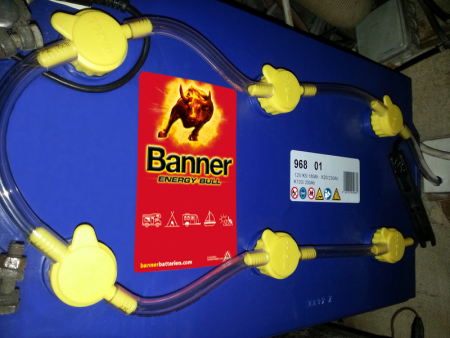BATTERY DEGASSING
EVERYTHING YOU NEED TO KNOW
Chemical reactions inside the battery produce oxyhydrogen.
A degassing tube guarantees the correct and safe discharge of the gas.

Using a degassing tube
Is it necessary to use a degassing tube when installing a battery in the interior?
In the case of lead-acid batteries which are installed in the interior/passenger compartment, Banner makes the use of a degassing tube mandatory.
Some vehicles are provided with a tube with an attached angle piece to discharge the battery gases. If this applies to your vehicle, the tube must be inserted via the angle piece into the corresponding degassing opening of the battery. If there is a degassing opening on the other side, it must be closed with a sealing plug.
If you need to replace your battery degassing plugs or degassing tubes, please get in touch with your Banner customer adviser, your Banner sales partner or contact us directly online.
Please note:
For your own safety, always use safety goggles when handling lead-acid batteries.
Is it possible to change the degassing side of a Banner battery?
Yes, with many types of battery.
The Power Bull and Power Bull PRO European types (T-housings and H-housings, total height 175 or 190 mm) and the Running Bull AGM and Running Bull EFB batteries (European types in T-housings and H-housings, total height 175 or 190 mm) have an opening for connecting the central degassing system in the battery cover either on the left side (beside the negative terminal for batteries with circuit 0) or on the right side (beside the positive terminal for batteries with circuit 0).
If the side of the degassing opening is not suitable, the white plug can be removed and must be put back into the degassing channel on the opposite side (to prevent any oxyhydrogen from escaping).
To remove the plug, please use a wooden screw with a diameter of approx. 5 mm. Don’t worry, you can’t insert the plug into the battery.
Please note: The Starting Bull and Energy Bull European types (total height 175 or 190 mm) have the opening for connecting the central degassing system
- for housings T/H 4, 5 and 6, on the right-hand side (+ terminal side for circuit 0, - terminal side for circuit 1) or
- for housings T/H 7, 8, D26 and LOT7, on the left-hand side (- terminal side for circuit 0, + terminal side for circuit 1) or It is not possible to change the degassing side.
The current installation situations are briefly noted here:
At BMW and Mercedes-Benz, all batteries in the currently built vehicles are degassed on the positive terminal side. This means on the right side for batteries with circuit 0.
Within the VW Group, all batteries in the currently built vehicles are degassed on the negative terminal side. This means on the left side for batteries with circuit 0.
PS: The bestseller is the degassing hose (length 90 cm) with elbow - order number 1030001700. If necessary, the hose can be shortened with scissors or a Stanley knife.
Good to know! For the Asia-JIS* types Running Bull EFB and Power Bull (total height 222 to 226 mm), the remaining degassing opening must now be closed with a white plug - order number 301566131002.
*JIS = Japanese Industrial Standards

Banner tip: Reisskamina central degassing system
This system for easy and safe retrofitting was developed specifically for long-term discharge batteries in the hobby and leisure segment, without an integrated central degassing unit in the battery cover.
Ideal for all Energy Bull flat cover batteries with 27 mm screw connections (battery box A – type 960 51, box B – type 963 51 and box C – type 968 01).
Can also be used for Buffalo Bill utility vehicle batteries with flat cover and 27 mm screw connections (battery box A – type 620 34/640 35, box B – type 680 32 and box C – type 725 11).
AGM and gel batteries do not emit any gas under normal operating conditions (unless there is a fault with the charger or the battery).

This prevents overcharging of the battery!
A Banner Accucharger prevents overcharging of the battery and extreme gassing!
What happened here?
Charging and subsequently overcharging of a discharged start-stop battery in a car workshop, unattended overnight of course, with a so-called workshop charger with W-characteristic (falling current with rising voltage = transformer characteristic).
Workshop chargers only have a voltage limiter (often only at approx. 15.5V !). During the charging process, the voltage (volts) constantly increases while the charging current (amperes) constantly decreases. The charging process must always be stopped manually in time to avoid overcharging, overheating and excessive outgassing of the battery!
PS: The battery also lacks a degassing hose for the correct and safe discharge of oxyhydrogen gas!
You might also be interested in the following

